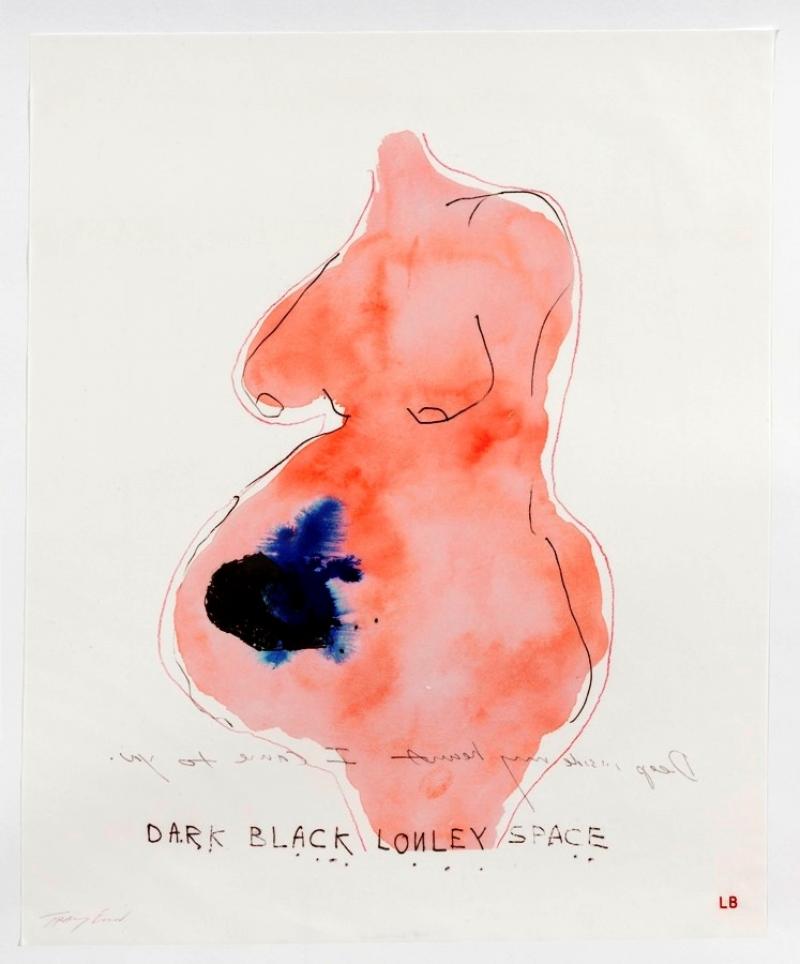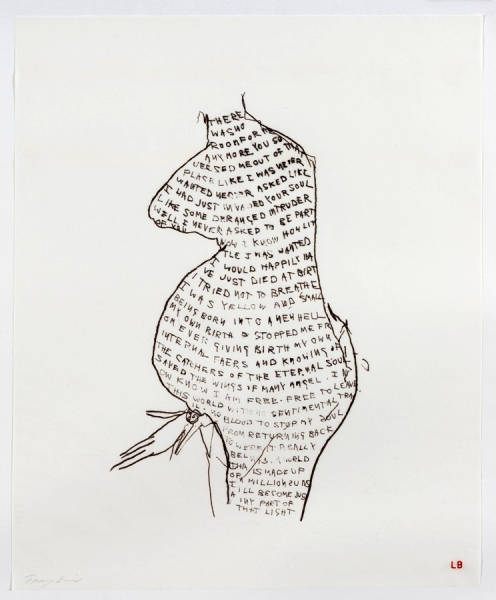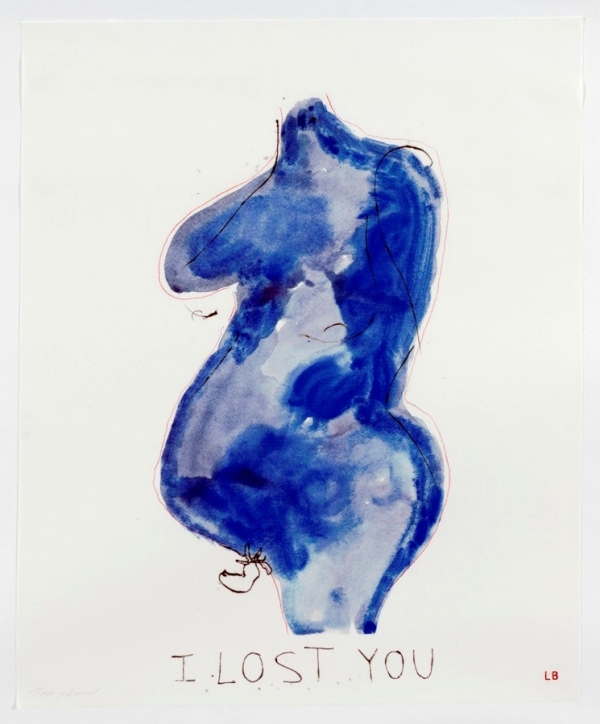Louise Bourgeois & Tracey Emin, Do Not Abandon Me, Hauser & Wirth | reviews, news & interviews
Louise Bourgeois & Tracey Emin, Do Not Abandon Me, Hauser & Wirth
Louise Bourgeois & Tracey Emin, Do Not Abandon Me, Hauser & Wirth
A great double act, or two sides that don't quite cohere?

Louise Bourgeois died last year at nearly 100, a revered figure: survivor of the Surrealist movement into the 21st century, a pioneer of autobiographical expression, whose fame came only late in life.
Bourgeois created a series of gouaches, male and female torsos in lovely veils of red, magenta and blue, which she then handed on to Emin, who incorporated her own spidery figures on them, using the disproportion of size to create narratives of psychic pain. Yet, unusually, Bourgeois’s original paintings are decidedly un-narrative, relying on the liquid colours and the febrile, fragile lines surrounding them to produce their own aura of tone, rather than of history. For an artist who made a fetish of translating her life into art, Bourgeois has here produced figures that are rather serene and detached. This is not Bourgeois at her finest - for that one has to go back several decades at least. But her share of this collaboration is work of skill, serenity and balance.
 Until, of course, Emin has performed. For Emin’s art is always about performance, and for an artist who produces in so many media – prints, photography, film, neon, fabric, installations and more – her performances have become rather predictably repetitive. Here once more are her tiny scribbled line drawings of women, legs splayed, cavorting this time over and across and underneath these rolling hills and valleys of flesh. Here is the familiar lettering, the words almost but not quite making sense: "THERE IS NO SPACE IN MY HEART IT DIED WHEN MY CUNT STOPPED LIVING YOU KILLED IT WITH YOUR LACK OF DESIRE...". Here are the scribbled-out messages, "You kept fucking me", with all of it crossed out except the "me", and, underneath, "you" repeated over and over across the white ground: "me", "you" "you" "you". (Pictured right, I just died at birth.)
Until, of course, Emin has performed. For Emin’s art is always about performance, and for an artist who produces in so many media – prints, photography, film, neon, fabric, installations and more – her performances have become rather predictably repetitive. Here once more are her tiny scribbled line drawings of women, legs splayed, cavorting this time over and across and underneath these rolling hills and valleys of flesh. Here is the familiar lettering, the words almost but not quite making sense: "THERE IS NO SPACE IN MY HEART IT DIED WHEN MY CUNT STOPPED LIVING YOU KILLED IT WITH YOUR LACK OF DESIRE...". Here are the scribbled-out messages, "You kept fucking me", with all of it crossed out except the "me", and, underneath, "you" repeated over and over across the white ground: "me", "you" "you" "you". (Pictured right, I just died at birth.)
One woman rests on an erect blue penis; another woman kneels in front of yet another blue penis, entitled I held your sperm and cried. The woman doesn't appear, however, to be crying, but reading a newspaper, or possibly looking at a menu as the sperm rains down, which itself looks vastly more like cuts of meat than sperm, or even liquid.
Indeed, it is almost impossible to look at the little scuttly figures spread literally and figuratively across the prints and not start a mental comedy routine. Just hanging shows (another) blue penis, this time with a woman hanging from a noose at its end. I’m afraid that what immediately sprang to mind was not Emin’s litany of rape, trauma, rejection, trauma, incest (and did I mention trauma?), but instead the cartoons of the wonderful Jacky Fleming, a feminist who refuses to whimper. (Her "Will the prince remain a quivering blob of frogspawn or will the kind princess swallow some and thereby save him? Probably not" seems a much more valuable lesson than I held your sperm and cried, or even I lost you (pictured below).)
 I am being frivolous, of course. But the point I want to make is a real one. Emin, despite all the personality hoopla, which is irrelevant, is a serious artist. Why, therefore, is it becoming increasingly difficult to take her seriously? Part of it, I think, is that she has been unable to reconcile her artistic narrative of herself as victim with the success of that victim - herself - as a person. That portrayal of a damaged psyche that has such free play over so many decades and so much art has never developed: Emin-the-victim never seems to learn, never seems to change or develop, but instead just continues to revel in her state of damage. For an adolescent, or an artist in her twenties, this would be entirely comprehensible; for a woman heading for 50, it becomes faintly embarrassing.
I am being frivolous, of course. But the point I want to make is a real one. Emin, despite all the personality hoopla, which is irrelevant, is a serious artist. Why, therefore, is it becoming increasingly difficult to take her seriously? Part of it, I think, is that she has been unable to reconcile her artistic narrative of herself as victim with the success of that victim - herself - as a person. That portrayal of a damaged psyche that has such free play over so many decades and so much art has never developed: Emin-the-victim never seems to learn, never seems to change or develop, but instead just continues to revel in her state of damage. For an adolescent, or an artist in her twenties, this would be entirely comprehensible; for a woman heading for 50, it becomes faintly embarrassing.
What I am really saying, and what this exhibition of Emin's now-traditional half-formulated thoughts brings home so clearly, is, I wished I liked Tracey Emin’s work more. But I can’t take it seriously because she takes herself so seriously she has been unable to grow. Or, indeed, grow up.
- Louise Bourgeois and Tracey Emin: Do Not Abandon Me, at Hauser & Wirth until 12 March
 Find books on Louise Bourgeois on Amazon
Find books on Louise Bourgeois on Amazon Find books on Tracey Emin on Amazon
Find books on Tracey Emin on Amazon
Explore topics
Share this article
Add comment
The future of Arts Journalism
You can stop theartsdesk.com closing!
We urgently need financing to survive. Our fundraising drive has thus far raised £49,000 but we need to reach £100,000 or we will be forced to close. Please contribute here: https://gofund.me/c3f6033d
And if you can forward this information to anyone who might assist, we’d be grateful.

Subscribe to theartsdesk.com
Thank you for continuing to read our work on theartsdesk.com. For unlimited access to every article in its entirety, including our archive of more than 15,000 pieces, we're asking for £5 per month or £40 per year. We feel it's a very good deal, and hope you do too.
To take a subscription now simply click here.
And if you're looking for that extra gift for a friend or family member, why not treat them to a theartsdesk.com gift subscription?
more Visual arts
 'We are bowled over!' Thank you for your messages of love and support
Much-appreciated words of commendation from readers and the cultural community
'We are bowled over!' Thank you for your messages of love and support
Much-appreciated words of commendation from readers and the cultural community
 Folkestone Triennial 2025 - landscape, seascape, art lovers' escape
Locally rooted festival brings home many but not all global concerns
Folkestone Triennial 2025 - landscape, seascape, art lovers' escape
Locally rooted festival brings home many but not all global concerns
 Sir Brian Clarke (1953-2025) - a personal tribute
Remembering an artist with a gift for the transcendent
Sir Brian Clarke (1953-2025) - a personal tribute
Remembering an artist with a gift for the transcendent
 Emily Kam Kngwarray, Tate Modern review - glimpses of another world
Pictures that are an affirmation of belonging
Emily Kam Kngwarray, Tate Modern review - glimpses of another world
Pictures that are an affirmation of belonging
 Kiefer / Van Gogh, Royal Academy review - a pairing of opposites
Small scale intensity meets large scale melodrama
Kiefer / Van Gogh, Royal Academy review - a pairing of opposites
Small scale intensity meets large scale melodrama
 Jenny Saville: The Anatomy of Painting, National Portrait Gallery review - a protégé losing her way
A brilliant painter in search of a worthwhile subject
Jenny Saville: The Anatomy of Painting, National Portrait Gallery review - a protégé losing her way
A brilliant painter in search of a worthwhile subject
 Abstract Erotic, Courtauld Gallery review - sculpture that is sensuous, funny and subversive
Testing the boundaries of good taste, and winning
Abstract Erotic, Courtauld Gallery review - sculpture that is sensuous, funny and subversive
Testing the boundaries of good taste, and winning
 Edward Burra, Tate Britain review - watercolour made mainstream
Social satire with a nasty bite
Edward Burra, Tate Britain review - watercolour made mainstream
Social satire with a nasty bite
 Ithell Colquhoun, Tate Britain review - revelations of a weird and wonderful world
Emanations from the unconscious
Ithell Colquhoun, Tate Britain review - revelations of a weird and wonderful world
Emanations from the unconscious
 Rachel Jones: Gated Canyons, Dulwich Picture Gallery review - teeth with a real bite
Mouths have never looked so good
Rachel Jones: Gated Canyons, Dulwich Picture Gallery review - teeth with a real bite
Mouths have never looked so good
 Yoshitomo Nara, Hayward Gallery review - sickeningly cute kids
How to make millions out of kitsch
Yoshitomo Nara, Hayward Gallery review - sickeningly cute kids
How to make millions out of kitsch
 Hamad Butt: Apprehensions, Whitechapel Gallery review - cool, calm and potentially lethal
The YBA who didn’t have time to become a household name
Hamad Butt: Apprehensions, Whitechapel Gallery review - cool, calm and potentially lethal
The YBA who didn’t have time to become a household name

Comments
...